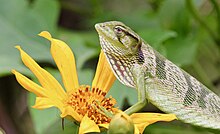Polychrus
Appearance
| Polychrus | |
|---|---|

| |
| Polychrus acutirostris | |
| Scientific classification | |
| Domain: | Eukaryota |
| Kingdom: | Animalia |
| Phylum: | Chordata |
| Class: | Reptilia |
| Order: | Squamata |
| Suborder: | Iguania |
| Family: | Polychrotidae |
| Genus: | Polychrus Cuvier, 1817[1] |
| Type species | |
| Draco marmoratus Linnaeus, 1758
| |
| Species | |
|
See text | |
Polychrus is the only extant genus of polychrotid lizards in the world.[2] Commonly called bush anoles, they are found in Central and South America, as well as nearby Trinidad and Tobago.
Polychrus means "many colored". True anoles in other genera are now placed in Dactyloidae. Polychrus is presently in the family Polychrotidae.[3][2]
Species

- Polychrus acutirostris Spix, 1825 – Brazilian bush anole
- Polychrus auduboni Hallowell, 1845 – Many-colored bush anole
- Polychrus femoralis Werner, 1910 – Werner's bush anole
- Polychrus gutturosus Berthold, 1845 – Berthold's bush anole
- Polychrus jacquelinae Koch, Venegas, Garcia-Bravo, and Böhme, 2011 - Jacquelin's bush anole
- Polychrus liogaster Boulenger, 1908 – Boulenger's bush anole
- Polychrus marmoratus Linnaeus, 1758 – Many-colored Bush Anole, Common monkey lizard
- Polychrus peruvianus Noble, 1924 - Peruvian bush anole
Fossil history
Though species of Polychrus have an almost exclusively South American distribution today, a stem representative, Sauropithecoides charisticus, was reported from the late Eocene of North Dakota, USA.[5][6]
References
- ^ Schlüter 2013: Cuvier 1817, Règne Animal 2: 40. Species typica: Lacerta marmorata Linnaeus.
- ^ a b "ITIS Report: Polychrus – Cuvier, 1817". Integrated Taxonomic Information System. 7 April 2016. Retrieved 2016-04-07.
- ^ "ITIS search results". Integrated Taxonomic Information System. 7 April 2016. Retrieved 2016-04-07.
- ^ Polychrus, Reptile Database
- ^ Smith, K.T. (2011) The evolution of mid-latitude faunas during the Eocene: Late Eocene lizards of the Medicine Pole Hills reconsidered. Bulletin of the Peabody Museum of Natural History 52: 3-105. https://doi.org/10.3374/014.052.0101
- ^ Smith, K.T. (2006) A diverse new assemblage of late Eocene squamates (Reptilia) from the Chadron Formation, North Dakota, U.S.A. Palaeontologia Electronica 9.2.5A.
Further reading
Wikimedia Commons has media related to Polychrus.
Wikispecies has information related to Polychrus.
- Berthold, A. A. 1845. "Über verschiedene neue oder seltene Reptilien aus Neu-Granada und Crustaceen aus China". Nachr. Georg-Augustus-Univ. und königl. Ges. Wiss. Göttingen 3: 37-48.
- Boulenger, G. A. 1908. "Descriptions of new South American reptiles". Ann. Mag. Nat. Hist., Ser. 8, 1 (1): 111−115.
- Koch, C., Venegas, P.J., Garcia-Bravo, A. & Böhme, W. 2011. "A new bush anole (Iguanidae: Polychrotinae: Polychrus) from the upper Marañon basin, Peru, with a redescription of Polychrus peruvianus (Noble, 1924) and additional information on P. gutturosus Berthold, 1845". ZooKeys 141: 79−107.
- Linnaeus, C. 1758. "Systema Naturae per Regna tria Naturae, secundum Classes, Ordines, Genera, Species, cum characteribus, differentiis, synonymus, locis. Ed. 10. Tomus I. – Salvius, Stockholm, 824 pp.
- Noble, G. K. 1924. "New lizards from northwestern Peru". Occasional Papers of the Boston Society of Natural History 5: 107−113.
- Schlüter, U. 2013. "Buntleguane - Lebensweise, Pflege, Fortpflanzung". KUS-Verlag, Rheinstetten, 78 pp. (A Monograph on Polychrus)
- Spix, J. B. von 1825. "Animalia nova sive species novae lacertarum,quas in itinere per Brasiliam annis MDCCCXVII-MDCCCXX jussu et auspiciis Maximiliani Josephi I. Bavariae regis". F. S. Hübschmann, München, pp. 1−26.
- Werner, F. 1910. "Über neue oder seltene Reptilien des Naturhistorischen Museums in Hamburg. II. Eidechsen". Mitt. Naturhist. Mus. Hamburg 27 (2): 1−46.
